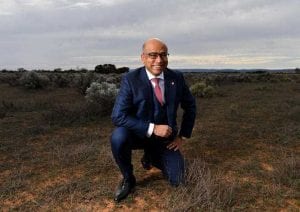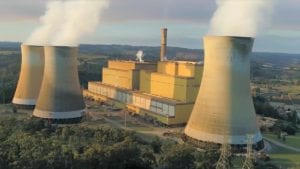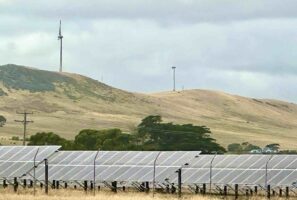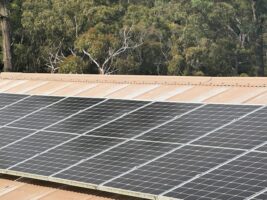
The Australian Greens have abandoned efforts to have a carbon price, and instead have favoured an interventionist approach to the energy sector, including mandating the exit of coal generation by 2030, and the banning of petrol cars by the same date.
The policy shift was unveiled by leader Richard di Natale, as the party sought to reposition itself in the wake of disappointing election campaigns, and amid a renewed push by the Far Right to do the exact opposite, and extend the life of coal by at least another half century.
“It’s time for government to step in,” di Natale told the National Press Club in Canberra.
“Government intervention now looks like the only pathway by which we will transition fast enough away from a centralised, polluting energy system to one designed around distributed renewable energy and storage.”
And yet, at the same time, the mining lobby and its new voice in the Coalition, the so-called Monash Forum, is pushing to protect centralised, polluting energy system through its own form of government intervention – a taxpayer-funded coal plant – to keep the industry going another 50 years.
The Coalition sought to paint Turnbull as “staring down” the Monash Forum’s push for new coal generation, and that was good enough for most mainstream media.
But at the same time as the Monash Forum were gathering signatures, the Turnbull camp was making frantic efforts to force AGL to extend the life of Liddell – the oldest and most clapped out power station in the country – or sell it to someone who would.
Energy minister Josh Frydenberg made calls to “connect”a group of manufacturing companies with the now Chinese owned retailer Alinta, with the view of making an offer to AGL. His spokesman said this call was made last week, and insisted it was “coincidental” with the Monash Forum unveiling.
On Tuesday, the day the Monash Forum demands became public, Turnbull rang up the AGL chairman yet again, urging the company to consider a sale of Liddell.
It is clear, however, that any such deal would have to involve government support of the type the hard right wants for new coal-fired generators, despite the denials by both Alinta and the government.
Alinta says, however, it only became interested in Liddell after the calls from Frydenberg and Turnbull before Easter.

It is also clear that the Coalition continues to ignore the advice of experts, in this the Australian Energy Market Operator. Turnbull said that without Liddell, the lights would not stay on in NSW.
“We know there is going to be a shortage in dispatchible power, electricity, in New South Wales,” Turnbull said.
Alinta was happy to further the myth. “We are pragmatic,” CEO Jeff Dimery told the ABC. “We understand that it’s nonsense and folly to believe that you can turn off coal-fired power stations today. You do that, and the lights go out on the east coast of Australia.”
This is a gross misrepresentation of the situation and goes against the very findings of the AEMO report that the government commissioned.
It is not the first time that the Coalition has refused to take expert advice, except for when it suits them. And it is certainly not the first, or the last time, that the coal industry has used the light out scare campaign.
Australia’s energy market seems destined, in some manner, to cease being a market. The interventionist approach by both the Greens and the Coalition – one to keep coal, the other to protect it, leaves Labor in the middle ground, but without any prospect of bi-partisan support.
The Greens abandonment of a carbon price will be ironic to many, particularly those who blame it for the death of the Rudd-inspired CPRS in 2010. But that version ignores Labor’s refusal to negotiate with the Greens on its contents.
When Labor had to negotiate with the Greens, in minority government in 2012, together they produced a remarkable policy package. But that package, as we know, was killed by the same right wing Coalition leadership that backed out of its deal on the CPRS, and now wants to protect coal for another generation.
The Greens have now given up on the carbon price idea, at least for now.
“For decades we’ve been told that we should trust the market to decide the most efficient way of reducing greenhouse gas emissions by putting a price on carbon,” di Natale said.
“Pricing carbon may well be the most cost-effective way of lowering climate pollution over the long term and we are very proud of our work to negotiate with the Gillard Government on a carbon price.
“But the science tells us we need a rapid transition. We are facing a climate emergency. We won’t achieve what’s necessary if the price on pollution is too low, vast sectors of the economy are carved out, and we fail to monitor the schemes effectively.
“The prospect of an effective carbon price in the current parliament is almost non-existent and we simply can’t afford to have another two decades of slow progress. Politics has so far failed us and we’ve reached the point where we can’t waste any more time.”
So the Greens proposal is to phase out all coal power stations by 2030, prevent government funding to prop up ageing clunkers like Liddell, and also to nationalise the interconnectors, as well as establish government energy retailer.
The irony is that this differs from the Coalition government only in its approach to coal. The Coalition has already bought itself a major generator and retailer, Snowy Hydro, and intends to use its funds to build Snowy 2.0.
On the subject of vehicles, it was interesting to note that the Australia car industry is now following the US in pushing back against any move to impose stricter regulations on emissions
The Australian Automobile Association, which represents the likes of NRMA and RAC, is pushing back against moves to improve Australia’s car fleet, which remains without parallel in the developed world as the dirtiest and least efficient, just like its electricity sector.
Chief executive Michael Bradley said any regulation will increase the price of cars, increase the price of petrol, and warned against going “too far.”










